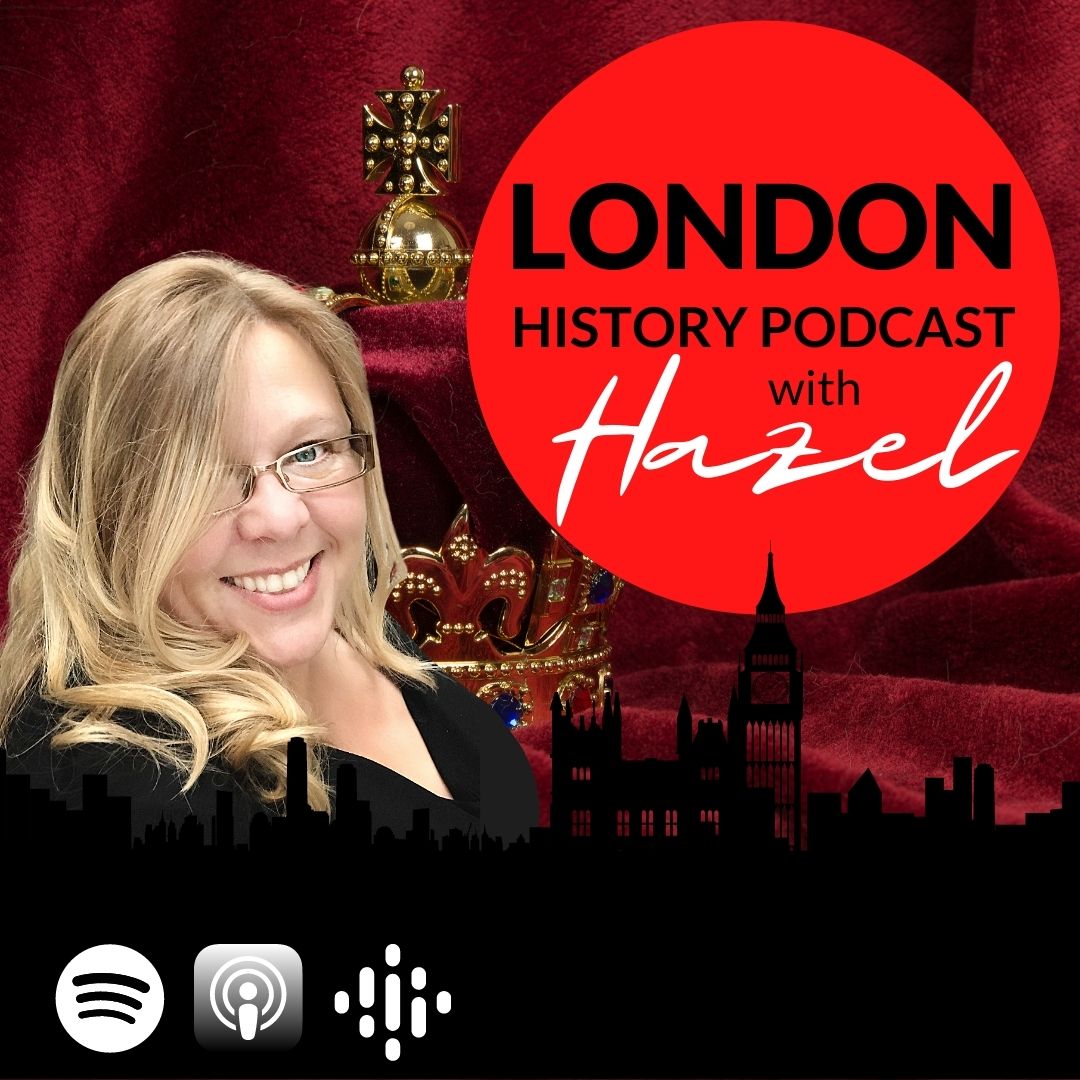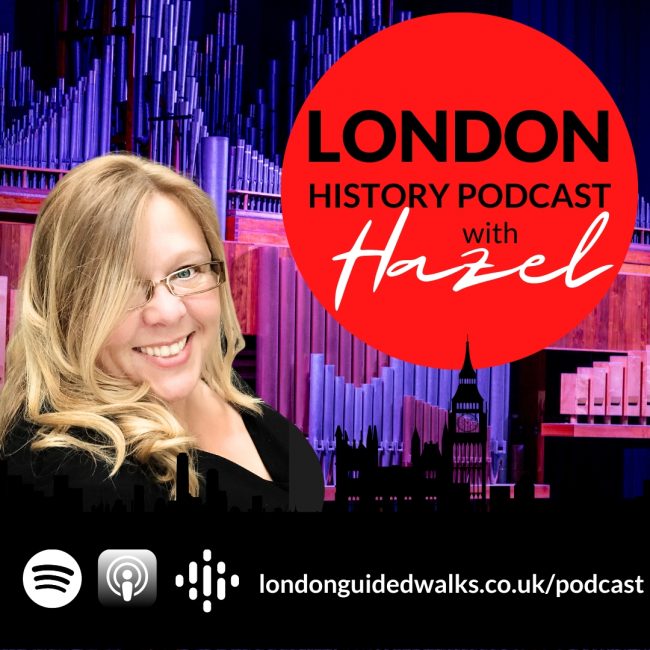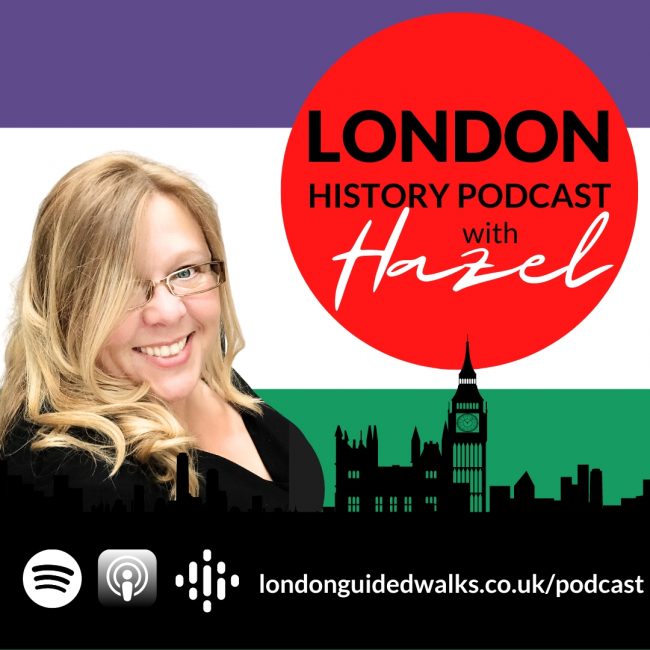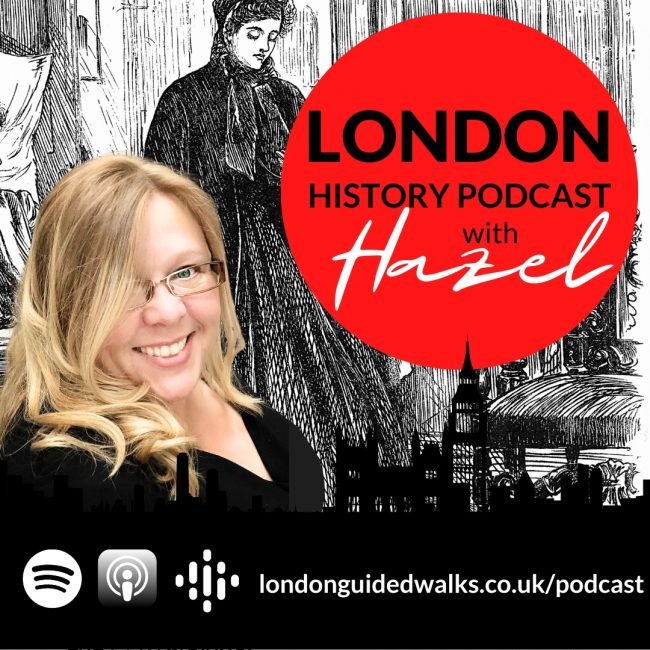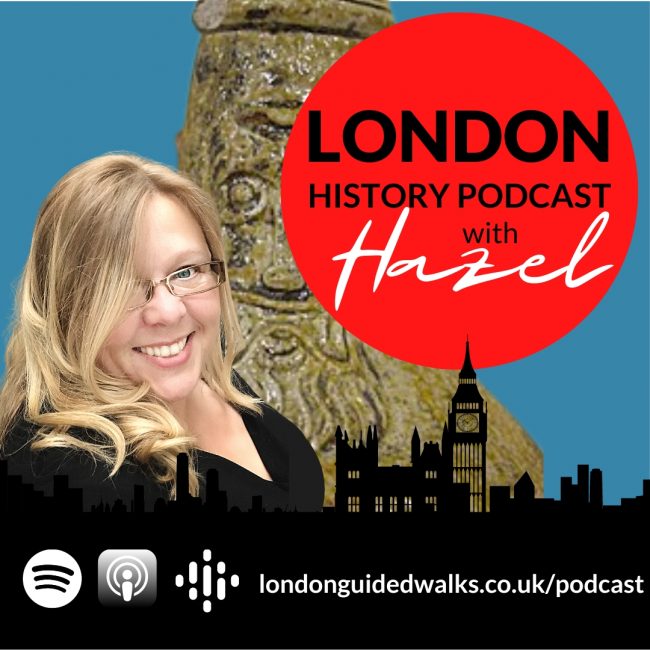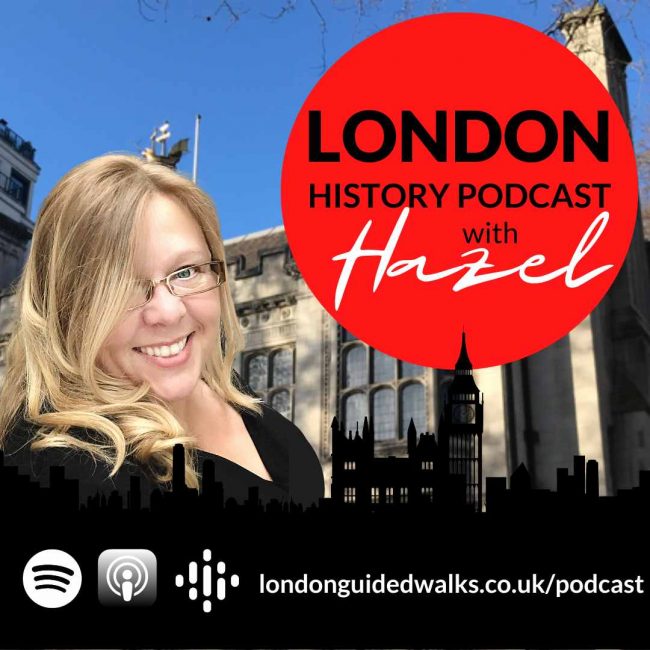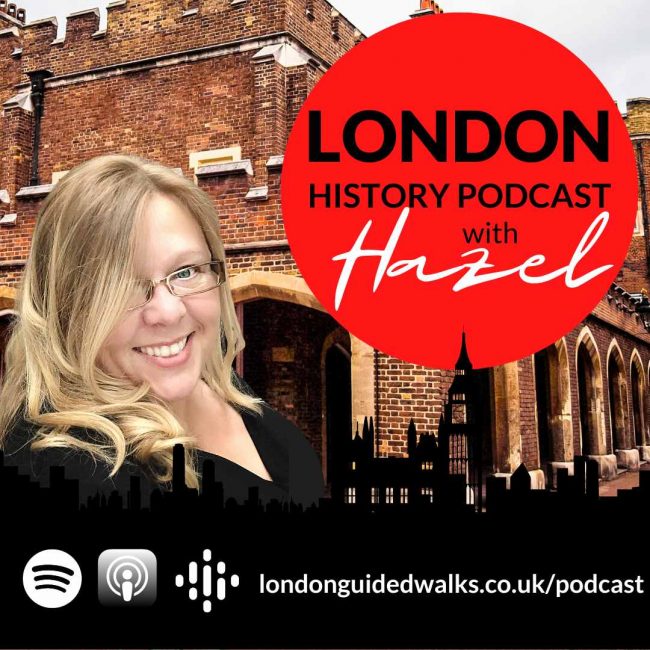Related Blog Post:
The Crown Jewels
Show Notes:

Your Host: Hazel Baker
Hazel is an active Londoner, a keen theatre-goer and qualified CIGA London tour guide.
She has won awards for tour guiding and is proud to be involved with some great organisations. She is a freeman of the Worshipful Company of Marketors and am an honorary member of The Leaders Council.
She has been an expert guest on Channel 5’s Walking Wartime Britain (Episode 3) and Yesterday Channel’s The Architecture the Railways Built (Series 3, Episode 7).
Hazel: Hello and welcome to London Guided Walks London History podcast. In the coming episodes, we will be sharing our love and passion for London, its people, places and history in an espresso shot with a splash of personality. For those of you who don’t know me, I am Hazel Baker, founder of London Guided Walks, providing guided walks and private tours to Londoners and visitors alike.
My first memory of London was when I was a brownie at six years old. We came down and we went to the Tower of London, and it wasn’t the bloody tower and the torture chamber, or indeed the armour that impressed me. Oh no, it was the bling, it was the crown, jewels and that is today’s subject. The Crown Jewels reside under armed guard in the jewel house at the Tower of London. It’s such a unique working collection of royal regalia with some still being used by the Queen for important and national ceremonies such as the State Opening of Parliament, and others are only used at a Monarch’s coronation.
Joining me today is Zoe Merritt, a certified London junkie, having worked at the National Maritime Museum in Greenwich, the Tower of London, and also St. Paul’s Cathedral. I cannot imagine working in such a historically fabulous place, such as the Tower of London, with such a unique collection of sacred and ceremonial objects, including all those super shiny jewels.
Zoe: I know, it was a bit of a bizarre experience because you see them without all the people there, and you’re like, “wow”.
Hazel: And the fibre optic units with accent lighting is spectacular, isn’t it?
Zoe: Oh, yeah, definitely. And you’re just like, especially in the morning when there’s no one there and you’re just opening up and everything and you’re just like, gaze at their incredibleness.
Hazel: And did you have a particular favourite display case or item that you absolutely loved?
Zoe: I have always been torn between the Queen mother’s council crown because it’s made of a solid platinum because the lady had class.
Hazel: She most certainly did. I mean, I can’t get over how the Queen mother’s council crown was set with 2800 diamonds. And of course, that includes the infamous Kooh-i-Noor diamond, one of the largest cut diamonds in the world weighing 105.6 carats, practical too, because it’s also on a detachable Platinum mount. You said you were torn. So, what was your other favourite?
Zoe: The Imperial State Crown because it’s got some of the most historic stuff in it. But it’s amazing but thing is, like the thing I find is like, about the fact that the spoon is the oldest item in the crown jewels and I’m like, because technically, there’s the Ruby in the Imperial state crown and the Sapphire which are older because the Ruby in the Imperial State Crown was given to put the black prince after he helped out Pedro of Castile in the Civil War and the Sapphire is known as St Edward’s Sapphire which was worn by a ring by Edward the Confessor and I’m like, the Tower of London is technically basically saying that the spoon is the oldest thing when it’s really not.
Hazel: So, the Imperial State ground that you mentioned with all the Black Prince Ruby in that, and that’s the one that the Queen wears, isn’t it for state opening of Parliament?
Zoe: Yeah, it is.
Hazel: Visitors to the Crown Jewels single this world famous, priceless collection, do they believe it’s real?
Zoe: Some did, some just believed it was false, that it wouldn’t be on public display as it is, but technically they’re not owned by the crown. They’re owned by the country. Of course, they’re going to be on display.
Hazel: And what other sort of questions were you asked?
Zoe: There were just loads of questions that we always got with regards to who’s going to be next in line, who’s going to be King, everyone thought that Charles wasn’t going to be King, even though he is, and they thought it would jump straight to William. And just with like the whole monarchy itself, I think people just didn’t quite believe the wealth of it all.
Hazel: Now, that spoon, I do remember seeing it, it is rather beautiful and quite delicate, and that’s used for the oil at the coronation, and then that’s next to, I can’t remember what kind of bird it is, for holding the oil.
Zoe: So, a simple name is the Ampulla, but it’s an eagle. Now, they use the eagle because an eagle was said to fly above the clouds, in Christianity, seen as a messenger of God because it can’t fly that high so, they use it as a religious symbolism.
Hazel: Now, some of you listeners may be wondering why we’re going on about an 11th century coronation spoon. Well, that’s because most of the Royal Collection that we had was destroyed in the Civil War. Now, this was during the reign of Charles the first. Now, the civil wars that began in 1642 effectively ended with the execution of Charles the first in January 1649. Now, after his execution, many of the crown jewels were sold or destroyed and effectively removing all sacred symbols of the monarchy. The Lord Protector Oliver Cromwell ordered that the orb and sceptre should be broken down as they stood for the detestable rule of kings. The coronation regalia was then brought to the Tower of London and destroyed by order of Parliament. They ordered that the highly symbolic coronation regalia be totally broken and defaced. Now, officials at the towers jewel house put up a fight. There was Colonel Mildmay who was the jewel house clerk and he was a royally sympathiser and made things as difficult as possible, even refusing to hand over the keys to these parliamentarians. Finally, he was arrested and imprisoned, and the doors to the jewel house strong room were broken down. Now, the precious stones were prized out of the crowns and sold, and the gold frames were sent to the tower meant to be melted down and turned into coins, and they were stamped with commonwealth of England. And these coins, these 1649 coins were produced following Cromwell’s Puritan beliefs. The wording appeared in English rather than Latin, the monarchs portraiture was abandoned, resulting in a very heraldic coin bearing the Cross of St. George on both sides, because of course, what do you do if you don’t have a monarchs head on one of them?
All the gemstones as I mentioned, they were removed and they were sold, and it basically just got lost within that, and that’s why this spoon is so important. It’s one of the original pieces, and then of course, it then took absolute fortune, a lot of dedication to try and rebuild the crown jewels that you see now. So, two new sceptre herbs and an orb costed 12,185 pounds to be remade for the coronation of Charles II in 1661. And that’s the restoration of the monarchy when Cromwell was no more. And this is a subject that we cover on our windows of Whitehall tour as well. So, 1666 Charles II is now back, the monarchs have been restored. 1661, the coronation is booked, what next?
Zoe: So, Charles II pretty much had to restore the whole of the crown jewels from scratch and what he could find and what that was sold off, to pretty much recreate the whole thing.
Hazel: And that’s where the spoon comes into play, isn’t it?
Zoe: Because it was so, I think it was one of the few items that wasn’t destroyed, a gentleman at the royal bed chamber, he kept it and then sold it back to Charles II, he gratefully accepted, thankfully.
Hazel: And what about Charles II’s involvement in remaking all of this regalia? Was he involved or did he just, I mean, he was a man of style, wasn’t he? Surely, he would have wanted to get into designing a bling.
Zoe: He did, some of it was very much in the old traditional style, but there’s a few pieces if you look, it’s one of the big plates, which is known as the Last Supper plate. He has a bit of his own stamp on it. King Charles is on it, a checkerboard floor and a chandelier on the Last Supper plate, which obviously didn’t exist in the Last Supper. It kind of has his little bit of a stamp, I thought.
Hazel: So, it was bit more of a stickler for tradition?
Zoe: In some ways, yes. I think especially with the crown jewels, I think they have to have the particular symbols of Christianity and the role with the church.
Hazel: I suppose it helps him reaching into the past to show that he actually belongs there.
Zoe: Definitely.
Hazel: And what about the sceptres? I remember seeing two, one with a huge diamond on top, what was that?
Zoe: So, there are two main sceptres. One is a symbol of kingship and authority, that’s the one with the Cullinan one in it, and there’s also a sceptre with a dove at the top with open wings. Now, the open wings is a symbol of the monarch and their power, but the one with the Cullinan one in it is the most important one. That was adapted obviously when they found the Cullinan diamond because that was a much later addition to the crown jewels.
Hazel: I mean, it’s huge, isn’t it?
Zoe: It’s like 502 carats of diamond.
Hazel: Wow. Hard to get your head around though, isn’t it?
Zoe: And I’ve been lucky enough to see it out the case and everything and it’s amazing.
Hazel: And what are these crown jewels for? Are they only for coronations?
Zoe: So, a lot of the crown jewels are simply for coronational purposes. So, some of them haven’t been used since obviously, the Queen’s coronation every three, some items are used more regularly. So obviously the Imperial state crown in 83. Some items are used more regularly so, obviously, The Imperial State Crown is used every year for the state Opening of Parliament. And there are some items that are used for, things like Maundy Thursday. Technically, they wouldn’t have been used this year because of lock down, but they would go every year to different places within England when the Queen delivers Maundy money. And also, there would be the baptismal font, which it would be used for baptisms of the Royal Family. So, would have been last officially years, for quite possibly Archie, which was for Harry and Meghan’s boy last year.
Hazel: I mean, there’s a lot of bling there, do many people think it’s solid gold?
Zoe: The only thing that is really solid gold is this St Edwards crown which is solid 22 karat gold. Everything else is silver gilt. So, its solid silver covered in gold because gold as a metal is generally quite weak, so, they usually use a solid– much more solid base and then cover it in gold just because it makes it stronger and it will last longer.
Hazel: That makes more sense, because there have been a few accidents, haven’t there?
Zoe: Yeah.
Hazel: Yeah. I think it was James II coronation banquet in 1685, and the sovereign sceptre with the cross was badly damaged. I think, they think it possibly rolled off the table during the celebrations, and then two jewelled pieces were later found on the floor of Westminster Hall. Now, Queen Victoria’s Imperial State crown was carried by the elderly Duke of Argyll for the state Opening of Parliament and he had it on a cushion and he dropped it and it hit the ground and it got crushed and squashed. And Queen Victoria writes how where it looks like a pudding that had sat down. Shows you how difficult it is when you know you’ve got that amount of money on a pillow in front of your hands.
Zoe: Yeah, and it was also during– I think it was during the coronation of George the fifth where the St Edwards crown was put on backwards.
Hazel: Oh, well, gems are on the right way around, how can you tell?
Zoe: So, I’m sorry I haven’t got pictures to show you but if you’re looking straight directly at the St Edwards crown there, in the cross, there’s like a green stone in the top of the cross and a red stone and that’s how you know it’s the front. And also, they used to put a string at the front, the string got lost, or taken off and so, for George the fifth, it got put on backwards
Hazel: The crown must be really difficult to work, because it’s not something that you’re used to wearing every day, and they must be vastly heavy with all of those jewels and silver and gold gilt and all the rest of it. And then of course, they’re really tall as well, aren’t they?
Zoe: Yes, so, the St Edwards crown weighs five pounds, which is about, in kilograms is just roughly about 2.2 kilograms, which is quite heavy. So, they only wear it for 15 to 20 minutes. The Imperial State Crown is a lot less because it’s not solid gold. So, thankfully, the Queen doesn’t have to really suffer that much now when she’s wearing it. And also, they pad it out to make it much more comfortable for them to wear.
Hazel: I suppose you got to have a few practices with it before going out in public.
Zoe: Yes, and so, if anyone’s ever watched the crown, where in the first series that she is leading up to the coronation, she did actually train, try things on and that’s one of the few things of the crown that’s actually true, that she did actually practice wearing them before the big day.
Hazel: And the Imperial State crown, I mean, there’s so many diamonds on there, aren’t there? I mean, it’s just absolutely covered in sparkle.
Zoe: And it also has the Cullinan II on the front of it, which is 317 carats worth of diamond. So, that’s definitely a lot of bling.
Hazel: I’ll tell you one of my favourite ones of all time, though, and you’re seeing all these big impressive ones, that small diamond crown that Queen Victoria had made?
Zoe: I know, it’s so cute and it’s so tiny.
Hazel: Yeah, it is. I just thought it was, it made me feel really sad thinking about how she is a mother to nine children, she is a new widow, she is the Queen of England. And so, she’s got all of these different roles that she needs to do all at the same time. And so, a crown is just not going to allow her to wear her widows’ weaves. So, to have this designed so she can do her duty and be the widow as well, I thought that was rather clever.
Zoe: And I love the fact that when she also passed, because it was made out of her own jewels, it was actually hers. So, when she passed she actually donated it to the country. So, that’s why it became part of the display of the crown jewels because she donated it because it was her gift to the nation.
Hazel: That’s lovely because, she used the Queen Charlotte’s nuptial crown, didn’t she? It’s bit of a basis for creation of this one, and that went back to Queen Charlotte’s family. So, it’s nice to have something that’s so delicate because, of course we think of Queen Victoria is like this rather round, a woman in black looking rather severe. But of course, you know, she was made a widow at the age of 42, that’s no age. And of course, it shows her a feminine side, which we don’t often see, and when she becomes widow.
Zoe: I definitely agree. And I thought that it just is so small and dainty and feminine, and it’s just so simple compared to everything else in there.
Hazel: Yes, it does look the odd one out in there. And for those who haven’t been to see the crown jewels at all, or haven’t been for a while, it’s more of an exhibition now. It’s not just glass containers with all the crown jewels, there’s a conveyor belt, there’s a journey explaining the importance of the jewels and the history and the heritage there, and about coronations themselves. So, you can learn really quite a lot in that time.
Zoe: Oh yeah, definitely. It’s more of– it gives you more of an overview of how the monarchy as a whole, and part of that they play in the coronation and the build-up and it kind of goes in sync with how they really laid out during the coronation, of the kind of the steps you would get through, which is good. And I think it gives kind of people a bit more of an insight rather than just, “Oh, there’s a crown.”, or “There’s a spoon.”, sometimes people don’t necessarily know what they’re looking at.
Hazel: Yeah, that certainly helps. But saying that, you know, if you saw these out in the world, I doubt that you’d get to see the real colours like you do, how they’re set up in there with the lights and the, you know, the backdrop; it’s really quite beautiful
Zoe: Because when you look at, if you ever see the Queen with her crown on in Parliament, it doesn’t look the same. Like, I always think it looks a bit duller because of the lighting in Parliament, and it’s the same for the jewels in your life, stay here all the time please.
Hazel: Yes, I thought that about my engagement as well. Wasn’t there a Colonel Blood who tried to steal some of the crown jewels? Do you remember that?
Zoe: Yes. So, basically he attempted to steal the crown jewels during the reign of Charles II, pretty much managed– he got in, bumped the guy of the head with a bar or some kind of weapon, got to the exit of the Tower of London before he got caught. However, he got pardoned. Basically, he refused to talk to anyone but Charles II. Charles II agreed and let him off with a pension and land and his life still.
Hazel: I wonder what he said to Charles II?
Zoe: I always like to joke with people, it’s quite possibly an insurance scam, to see if it could work, possibly, but that was just a theory.
Hazel: One of the new things for 2020 is that His Royal Highness the Prince of Wales, investiture coronet is on display in the jewel house for the first time. Now, the coronet is part of the Royal Collection and has joined the other coronets of the other two Prince of Wales. For the investiture, as Prince of Wales at Caernarfon castle in 1969, Prince Charles wore the contemporary coronet designed by an architect in Goldsmith Louie Osman, and I do think it’s rather stylish. It’s made of gold and platinum and set with diamonds and emeralds with the purple velvet and ermine cap of estate. Now, don’t forget those who are residents of Tower Hamlets, you’re able to get entrance into the Tower of London for a smear pound. So, you need to bring your idea store card, also with a proof of identity and also make sure when you go, it’s not in lock down.
So, that’s all we have time for today. I hope you enjoyed it and learned few new things. Big thanks to Zoe for taking the time to share her love of London with us.

